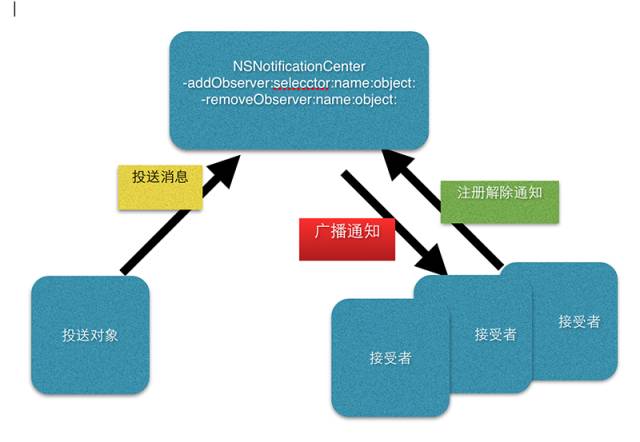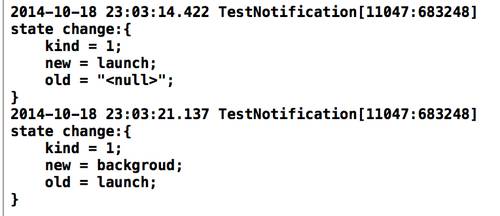在iOS开发我们经常碰到只需要某类一个实例的情况,最常见的莫过于对硬件参数的访问类,比如UIAccelerometer.这个类可以帮助我们获得硬件在各个方向轴上的加速度,但是我们仅仅需要它的一个实例就够了,再多,只会浪费内存。
所以苹果提供了一个UIAccelerometer的实例化方法+sharedAccelerometer,从名字上我们也能看出此方法让整个应用共享一个UIAccelerometer实例(PS:iOS 的开放中,我们往往能从方法名中就了解这个方法的作用),它内部的如何实现我们暂且不谈,先来看看还有哪些类同样使用了单例模式。
UIApplication类提供了 +sharedAPplication方法创建和获取UIApplication单例
NSBundle类提供了 +mainBunle方法获取NSBundle单例
NSFileManager类提供了 +defaultManager方法创建和获得NSFileManager单例。(PS:有些时候我们得放弃使用单例模式,使用-init方法去实现一个新的实例,比如使用委托时)
NSNotificationCenter提供了 +defaultCenter方法创建和获取NSNotificationCenter单例(PS:该类还遵循了另一个重要的设计模式:观察者模式)
NSUserDefaults类提供了 +defaultUserDefaults方法去创建和获取NSUserDefaults单例
等等,苹果的SDK中大量的遵循此设计模式,那么它的内部是如何实现的呢?
首先给大家介绍一下GCD技术,是苹果针对于多核CPU的多任务解决方案。你不需要了解更多,只需要知道是一组基于C语言开发的API。GCD提供了一个dispatch_once函数,这个函数的作用就是保证block里的语句在整个应用的生命周期里只执行一次。
OK,接下来就给出一个使用了单例模式新建和获取实例的类模版,代码如下:
//Singleton.h@interfaceSingleton:NSObject+ (Singleton *)sharedSingleton; <1>@end/***************************************************************///Singleton.m#import"Singleton.h"@implementationSingletonstaticSingleton *sharedSingleton = nil;<2>+ (Singleton *)sharedSingleton{staticdispatch_once_tonce;<3>dispatch_once(&once,^{ sharedSingleton = [[selfalloc] init];<4>//dosometing});returnsharedSingleton;<5>}
上述代码中有5小步,解释如下:
声明一个可以新建和获取单个实例对象的方法
声明一个static类型的类变量
声明一个只执行一次的任务
调用dispatch_once执行该任务指定的代码块,在该代码块中实例化上文声明的类变量
返回在整个应用的生命周期中只会被实例化一次的变量
OK,这就是iOS开发中单例模式的机制,下面我们就看看如何在实际开发中使用此模式?(PS:为了尽可能的突出核心内容,我们会对设计中的其他模式或内容一笔带过)
假如我们需要在iOS应用中实现分层的架构设计,即我们需要把数据的持久层,展示层,和逻辑层分开。为了突出重点,我们直接把目光转到持久层,而根据MVC的设计模式,我们又可以把持久层细分为DAO层(放置访问数据对象的四类方法)和Domain层(各种实体类,比如学生),这样就可以使用DAO层中的方法,配合实体类Domain层对数据进行清晰的增删改查。那么我们如何设计呢?
从使用者的角度看,我们期望获得DAO层的类实例,然后调用它的增删改查四大方法。可是这个类实例,我们似乎只需要一个就足够了,再多的话不利于管理且浪费内存。OK,我们可以使用单例模式了,代码如下:
.h文件:
//StudentDAO.h@interfaceStudentDAO:NSObject@property(nonatomic,strong) NSMutaleArray *StudentsInfo;+ (StudentDAO *)sharedStudentDAO;-(int) create:(Student*)student;-(int) remove:(Student*)student;-(int) modify:(Student*)student;-(NSMutaleArray) findAll;@end
.m文件:
//StudentDAO.m#import"StudentDAO.h"#import"Student.h"@implementationStudentDAOstaticStudentDAO *studentDao = nil;+ (StudentDAO)sharedStudentDAO{staticdispatch_once_tonce;dispatch_once(&once,^{ Student *student1 = [[Student alloc]init]; student1.name="MexiQQ"; student1.studentNum="201200301101"; Student *student2 = [[Student alloc]init]; student2.name="Ricardo_LI"; student2.studentNum="201200301102"; studentDao = [[selfalloc] init]; studentDao._StudentsInfo= [[NSMutaleArray alloc]init]; [studentDao._StudentsInfoaddObject:student1]; [studentDao._StudentsInfoaddObject:student2]; });returnstudentDao;}//插入的方法-(int)create:(Student*)stu{ [self._StudentsInfoaddObject:stu];return0;}//删除的方法-(int)remove:(Student*)stu{for(Student* sinself._StudentsInfo){if([stu.studentNumisEqual:s.studentNum]){ [self._StudentsInforemoveObject:s]break; } }}-(int)modify......//省略不写-(NSMutaleArray)findAll......//省略不写
上述例子不难理解,其中用到的Student类我这里就不给出了,只是一个含有姓名和学号属性的实体类。
观察者模式
概念:一个对象状态改变,通知正在对他进行观察的对象,这些对象根据各自要求做出相应的改变
图例:
如图所示:操作对象向被观察者对象投送消息,使得被观察者的状态得以改变,在此之前已经有观察者向被观察对象注册,订阅它的广播,现在被观察对象将自己状态发生改变的消息广播出来,观察者接收到消息各自做出应变。
OK,我们先来看看在苹果的Cocoa Touch框架中有谁使用了观察者模式:
通知(notification)机制
原理图如下:
如图所示,在通知机制中对某个通知感兴趣的所有对象都可以成为接受者。首先,这些对象需要向通知中心(NSNotificationCenter)发出addObserver:selector:name:object:消息进行注册,在投送对象投送通知送给通知中心时,通知中心就会把通知广播给注册过的接受者。所有的接受者不知道通知是谁投送的,不去关心它的细节。投送对象和接受者是一对多的关系。接受者如果对通知不再关注,会给通知中心发送removeObserver:name:Object:消息解除注册,以后不再接受通知。
(ps:这段话内容摘抄自关东升先生的文章)
OK,我们试着去使用一下通知机制:
新建一个Single view Project,对项目中的文件做以下修改:
AppDelegate.m
- (void)applicationDidEnterBackground:(UIApplication*)application { [[NSNotificationCenterdefaultCenter]postNotificationName:@"APPTerminate"object:self];}
ViewController.m
//// ViewController.m// TestNotification//// Created by liwenqian on 14-10-18.// Copyright (c) 2014年 liwenqian. All rights reserved.//#import"ViewController.h"@interfaceViewController()@end@implementationViewController- (void)viewDidLoad { [superviewDidLoad];//注意此处的selector有参数,要加冒号[[NSNotificationCenterdefaultCenter]addObserver:selfselector:@selector(doSomething:) name:@"APPTerminate"object:nil];// Do any additional setup after loading the view, typically from a nib.}- (void)didReceiveMemoryWarning { [superdidReceiveMemoryWarning]; [[NSNotificationCenterdefaultCenter]removeObserver:self];// Dispose of any resources that can be recreated.}#pragma mark -处理通知-(void)doSomething:(NSNotification*)notification{NSLog(@"收到通知");}@end
如上所示,对模版项目的两个文件的方法或整个文件做出修改,Command+R运行你的APP,再按下Home键(Command+H),会发现打印出一行收到通知的文字,如下:
在APP退到后台时,发出广播,而viewController因为时观察者,收到广播,执行doSomething方法,打印出收到广播的文字。
KVO(Key-Value-Observing)机制
原理图如下:
如图所示:
该机制下观察者的注册是在被观察者的内部进行的,不同于通知机制(由观察者自己注册),需要被观察者和观察者同时实现一个协议:NSKeyValueObserving,被观察者通过addObserver:forKeypath:options:context方法注册观察者,以及要被观察的属性。
新建一个single view project,同时新建一个继承自NSObject的TestWatche类:文件结构如下图:
对文件进行如下修改:AppDelegate.h
//// AppDelegate.h// TestNotification//// Created by liwenqian on 14-10-18.// Copyright (c) 2014年 liwenqian. All rights reserved.//#import#import#import"TestWatche.h"@interfaceAppDelegate:UIResponder@property(strong,nonatomic)UIWindow*window;@property(readonly,strong,nonatomic) NSManagedObjectContext *managedObjectContext;@property(readonly,strong,nonatomic) NSManagedObjectModel *managedObjectModel;@property(readonly,strong,nonatomic) NSPersistentStoreCoordinator *persistentStoreCoordinator;@property(strong,nonatomic)NSString*state;@property(strong,nonatomic) TestWatche *watcher;- (void)saveContext;- (NSURL*)applicationDocumentsDirectory;@end
AppDelegate.m 对如下方法做出修改
- (BOOL)application:(UIApplication*)application didFinishLaunchingWithOptions:(NSDictionary*)launchOptions {// Override point for customization after application launch.self.watcher= [TestWatche alloc]; [selfaddObserver:self.watcherforKeyPath:@"state"options:NSKeyValueObservingOptionOld | NSKeyValueObservingOptionNew context:@"pass content"];self.state=@"launch";returnYES;}- (void)applicationDidEnterBackground:(UIApplication*)application {self.state=@"backgroud";}
TestWatche.m(由于继承自NSObject,而NSObject已实现了NSKeyValueObserving协议,所以不需要做声明)
//// TestWatche.m// TestNotification//// Created by liwenqian on 14-10-18.// Copyright (c) 2014年 liwenqian. All rights reserved.//#import"TestWatche.h"@implementationTestWatche-(void)observeValueForKeyPath:(NSString*)keyPath ofObject:(id)object change:(NSDictionary*)change context:(void*)context{NSLog(@"state change:%@",change);}@end
OK,Command+B Command+R Command+H看看你的应用输出了什么,如果你的操作无误的话,会显示如下内容:
委托模式
个人认为委托模式大多数人解释的复杂了,其实就像是java中的接口,类可以实现或不实现协议(接口)中的方法。通过此种方式,达到最大的解耦目的,方便项目的扩展。不过你需要设置应用的委托对象,以确定协议中的方法为谁服务。
拿最常用的UITableViewDelegate UITableViewDataSource来举例:
实现一个页面有一个UItableView,UItableView的每一栏(cell)的数据由我们指定,那么我们该如何做呢?苹果也自然想到了这一点,于是定义了一个接口,这个接口有许多的方法,只需要我们把要服务的对象传进去,就可以使用这些方法了,这个接口就是委托和协议。而UITableViewDelegate 和 UITableViewDataSource 就是专为UITableView而写的委托和协议。用法如下:
ViewController.h
//// ViewController.h// RecipeBookMe//// Created by liwenqian on 14-9-10.// Copyright (c) 2014年 liwenqian. All rights reserved.//#import@interfaceViewController:UIViewController@property(nonatomic,strong)IBOutletUITableView*mytableView;@end
ViewController.m
//// ViewController.m// RecipeBookMe//// Created by liwenqian on 14-9-10.// Copyright (c) 2014年 liwenqian. All rights reserved.//#import"ViewController.h"#import"DetailViewController.h"#import"Recipe.h"#import"RecipeTableCellTableViewCell.h"@interfaceViewController()@end@implementationViewController{NSArray*recipes; }@synthesizemytableView;- (void)viewDidLoad { [superviewDidLoad];// Initialize the recipes arrayRecipe *recipe1 = [Recipe new]; recipe1.name=@"Egg Benedict"; recipe1.prepTime=@"30 min"; recipe1.image=@"egg_benedict.jpg"; recipe1.ingredients= [NSArrayarrayWithObjects:@"2 fresh English muffins",@"4 eggs",@"4 rashers of back bacon",@"2 egg yolks",@"1 tbsp of lemon juice",@"125 g of butter",@"salt and pepper", nil]; Recipe *recipe2 = [Recipe new]; recipe2.name=@"Mushroom Risotto"; recipe2.prepTime=@"30 min"; recipe2.image=@"mushroom_risotto.jpg"; recipe2.ingredients= [NSArrayarrayWithObjects:@"1 tbsp dried porcini mushrooms",@"2 tbsp olive oil",@"1 onion, chopped",@"2 garlic cloves",@"350g/12oz arborio rice",@"1.2 litres/2 pints hot vegetable stock",@"salt and pepper",@"25g/1oz butter", nil]; recipes = [NSArrayarrayWithObjects:recipe1, recipe2, nil];}- (void)didReceiveMemoryWarning { [superdidReceiveMemoryWarning];}/*--------------------------------------------------------------------*///定义UITableview的栏目数量- (NSInteger)tableView:(UITableView*)tableView numberOfRowsInSection:(NSInteger)section{return[recipes count];}//定义UITableviewCell的显示内容- (UITableViewCell*)tableView:(UITableView*)tableView cellForRowAtIndexPath:(NSIndexPath*)indexPath{staticNSString*CoustomerTableIdentifier =@"RecipeTableCellTableViewCell"; RecipeTableCellTableViewCell *cell =(RecipeTableCellTableViewCell *) [tableView dequeueReusableCellWithIdentifier:CoustomerTableIdentifier];if(cell == nil) { cell = [[RecipeTableCellTableViewCell alloc] initWithStyle:UITableViewCellStyleDefault reuseIdentifier:CoustomerTableIdentifier]; } recipe = [recipes objectAtIndex:indexPath.row]; cell.nameLabel.text= recipe.name; cell.prepTimeLabel.text= recipe.prepTime; cell.thumbnailImageView.image= [UIImageimageNamed:recipe.image];returncell;}//点击每一栏执行跳转时的处理- (void)prepareForSegue:(UIStoryboardSegue *)segue sender:(id)sender {if([segue.identifierisEqualToString:@"showRecipeDetail"]) {NSIndexPath*indexPath = nil; Recipe *recipe = nil; indexPath = [self.mytableViewindexPathForSelectedRow]; recipe = [recipes objectAtIndex:indexPath.row]; DetailViewController *destViewController = segue.destinationViewController; destViewController.recipe= [recipes objectAtIndex:indexPath.row]; }}//定义cell的高度- (CGFloat)tableView:(UITableView*)tableView heightForRowAtIndexPath:(NSIndexPath*)indexPath{return71;}/*--------------------------------------------------------------------*/@end
如上所示,两条/------/注释间的方法全部来自于委托和协议。利用委托和协议,你可以把主要精力放到逻辑业务上,将数据绑定和事件处理交给委托和协议去完成。
蓝鸥iOS开发,国内口碑最好的iOS培训学院,详情请咨询官方网站http://www.lanou3g.com我们是 一群热爱IT的年轻人,如果你也爱IT、爱iOS开发,欢迎前来蓝鸥iPhone培训中心参观学习,让我们共同为梦想发声。





